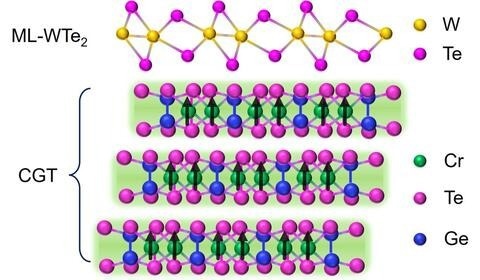A new magnetic state in a monolayer of the novel quantum material tungsten ditelluride, or WTe2, has been demonstrated by a research team at the University of California, Riverside, led by a physicist.
 In their experiments, the researchers stacked monolayer WTe2 with Cr2Ge2Te6, or CGT. Image Credit: Shi lab/UC Riverside
In their experiments, the researchers stacked monolayer WTe2 with Cr2Ge2Te6, or CGT. Image Credit: Shi lab/UC Riverside
This material, known as a magnetized or ferromagnetic quantum spin Hall insulator, has an insulating interior but a conducting edge, which has significant implications for managing electron flow in nanodevices. It is only one atom thick.
A typical conductor has uniform electrical current flow. On the other hand, insulators do not easily conduct electricity. Monolayer WTe2 is typically a particular insulator with a conducting edge; however, when it is magnetized, it acquires additional peculiar features.
We stacked monolayer WTe2 with an insulating ferromagnet of several atomic layer thickness—of Cr2Ge2Te6, or simply CGT—and found that the WTe2 had developed ferromagnetism with a conducting edge. The edge flow of the electrons is unidirectional and can be made to switch directions with the use of an external magnetic field.
Jing Shi, Study Lead and Professor, Physics and Astronomy, University of California, Riverside
According to Shi, when a material only conducts electricity along its edge, its interior size is irrelevant, enabling the manufacture of electronic devices as small as the conducting edge itself.
Devices made of this material might be more energy-efficient since they would use less power and radiate less energy. For instance, batteries adopting this technology might last longer.
The results of the study are published in Nature Communications.
The technology is now limited to extremely low temperatures; CGT becomes ferromagnetic at about 60 K. (or –350 F). Future work will concentrate on making the technology operate at greater temperatures, opening up a wide range of nano-electronic applications, including non-volatile memory chips for computers and mobile phones.
Shi claims that the conducting edge in ideal quantum spin Hall insulators consists of two parallel, narrow channels, similar to a two-lane motorway with opposing-moving traffic. According to Shi, unless contaminants are added, electrons flowing in one channel cannot pass over to the other channel.
Shi’s colleague and coauthor Yongtao Cui, an associate professor of physics and astronomy at UCR, first observed the conducting edge in monolayer WTe2 in an earlier study.
Shi stated, “It is two channels per edge. If you eliminate one channel, you end up with a current flowing only in one direction, leaving you with what is called a quantum anomalous Hall insulator, yet another special quantum material. Such an insulator has only one highway lane, to use the highway analogy. This insulator transports electrons in a fully spin-polarized manner.”
While the magnetized WTe2 that Shi and his associates used for their experiments is referred to as a ferromagnetic quantum spin Hall insulator, it has a conducting edge with partially spin-polarized electrons.
“In the two channels of ferromagnetic quantum spin Hall insulators, we have an unequal number of electrons flowing in opposite directions resulting in a net current, which we can control with an external magnet,” Shi added.
Shi contends that WTe2 and other quantum materials are the future of nanoelectronics.
Shi further stated, “The CHIPS Act will encourage researchers to come up with new materials whose properties are superior to those of current silicon materials.”
Cui and Xi Chen from UCR, as well as Mina Rashetnia, Mark Lohmann, and Youming Xu from their labs, all participated in the study with Shi.
When the study was conducted, first author Junxue Li was a postdoctoral researcher working in Shi’s lab. Jahyun Koo and Binghai Yan from the Weizmann Institute of Science in Israel, Xiao Zhang and Shuang Jia from Peking University in China, and Takashi Taniguchi and Kenji Watanabe from the National Institute for Materials Science in Japan are also coauthors of the paper.
Grants from the National Science Foundation and the Department of Energy helped Shi with the research.
Journal Reference:
Li, J., et al. (2022) “Proximity-magnetized quantum spin Hall insulator: monolayer 1 T’ WTe2/Cr2Ge2Te6. Nature Communications. doi:10.1038/s41467-022-32808-w.